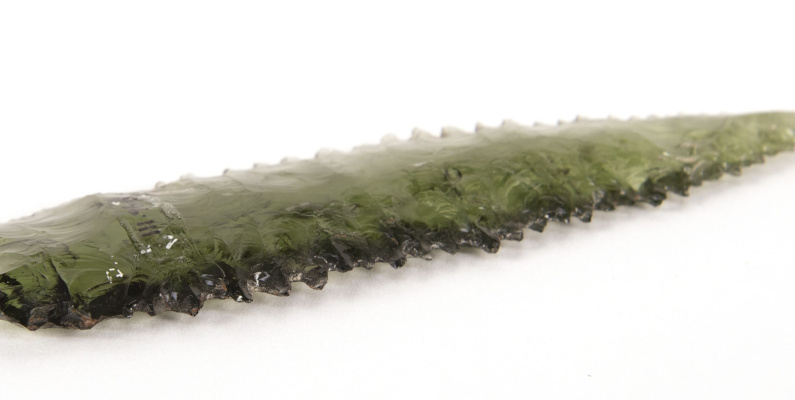
One of the windows attracting lots of visitor interest in ‘Keep it Glassy’ – Tūhura Otago Museum’s current stairwell case exhibition – displays three flaked glass spear points from north Western Australia. They are often called Kimberley points because they are made in the Kimberley region.
Much of the response has been because they look straightforwardly beautiful. Also, any sort of glass working produces a level of amazement but somehow the lighting in the current case seems perfectly positioned to draw attention to the intricate flaking required to produce them, at the same time as accentuating the inherent appeal of the material. They are part of a story of colonial collecting, and the relationship between objects and identity in settler societies, as well.

Clear glass spearhead with resin at base, Australia. D52.927. Tūhura Otago Museum Collection
The points are part of a tradition of skilled manufacture in the Kimberley region for over a thousand years. Early examples, however, were made from fine-grained stone. Making them from bottle glass, or porcelain insulators from telegraph poles, didn’t start until the late 19th century.
The Australian Museum website says that Kimberley points were primarily used as hunting implements and prestige items for exchange. 1 Tim Maloney, from Griffith University, has noted that overall the points “were hafted for hunting and fighting in recent times, although there is some suggestion that smaller points tended to be hafted for use in favour of larger points, which were reserved for trade and exchange”. 2
Rodney Harrison, of the NSW Parks and Wildlife Service, argued that Kimberley points played a role in ‘developing notions of social identity among antiquarian collectors and Aboriginal people in the late nineteenth and early twentieth centuries, particularly their role in evoking and expressing hybrid masculinities. The manufacture of glass Kimberley points by men who had been dislocated from their traditional country implies connections between the practice of point manufacture and the creation of new, hybrid social identities’.3
He has suggested there was an intensification in the number of points produced after 1885, as well as an increasing formalisation of point design, and that these changes were connected to post-contact social changes and the role played by non-Aboriginal collectors in selecting for particular point forms.4
A 1925 article about Western Australia by Michael Terry, printed in the Press, included the reporter’s account of watching one being made, albeit at his own request:
“Another industry was the chipping of spear-heads... a big thick bottle was handed to the workman, who, by careful tapping, broke it into several large pieces, measuring about three inches by four inches.
The piece he selected was tapped around the edge till it had assumed an oval shape. Then a stone was embedded in the ground between his legs, and some pieces of rag placed on top of it. On this soft support the rough spear-head was held on its edge. Following this [he] proceeded to flake off tiny chips of glass with a piece of sharpened wire till the crude article had become a beautifully symmetrical pear-shaped head, glistening and flaked all over, with serrated edges, except at the base, where it was left rough.”

Pressure flaked green glass point, Australia. D96.111. Tūhura Otago Museum Collection
The writer then described the process of attaching the point. Another member of the party had prepared some ca. 25cm long sticks, with knobs of ‘wax’ from the resined spinifex plant on one end. One of these was selected by the glass flaker, who “set about the waxed end … kneading it till the wax had become soft and pliable. When he was satisfied with this operation he imbedded the [spear] head in it and laid it on one side to cool. During hunting these short shafts were attached to a ten-foot length of shank, … the whole being thrown by a woomera or spear-thrower”.
The glass spear points seem to have been of interest in Aotearoa early on. A Miss Lawton displayed an “Australian spear from Kimberley” at a Riverton Mutual Improvement Association exhibition in September 1888. 5Canterbury Museum acquired two in 1901: “An interesting little addition has been made to the collection of stone spear heads, etc., at the Christchurch Museum, in the shape of two spear heads made out of bottles … in the northern part of West Australia. One spear head is made out of a portion of a lemonade bottle, and the other out of a portion of an ordinary wine bottle. Both have serrated edges and are trimmed and shaped in exactly the same manner as the old flint spear heads”.6

Green glass spear point with pressure flaking, Australia. X2022.201. Tūhura Otago Museum Collection
The three on display at Tūhura Otago Museum in Keep it Glassy were purchased later than those, separately, and at different times. They were most probably all produced for the tourist market. It seems that Kimberley points are both an enduring prehistoric artefact type and, as Harrison described them, “an artefact of colonial desire” and "virtuoso tourist art". 7
All photographs by Jen Copedo.
1. https://australian.museum/learn/cultures/atsi-collection/cultural-objects/kimberley-spear-points/
2. Maloney, T. 2020. Kimberley points of Western Australia: Pressure flaking, projections and prestige. Journal of Lithic Studies 7(1):26
3. Harrison, R. 2002. Archaeology and the colonial encounter: Kimberley spear points, cultural identity and masculinity in the north of Australia. Journal of Social Archaeology 2: 352-377.
4. Harrison, R. 2004. ‘Kimberley points and colonial preference: new insights into the chronology of pressure flaked point forms from the southeast Kimberley, Western Australia’.Archaeology in Oceania 39: 1-11.
5. Western Star, 29 September 1888: 2
6. New Zealand Herald, 24 May 1901: 5
7. Harrison, R. 2006. An artefact of colonial desire? Kimberley points and the technologies of enchantment. Current Anthropology 47: 63-88
